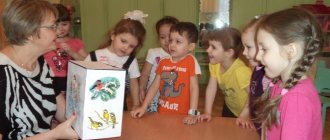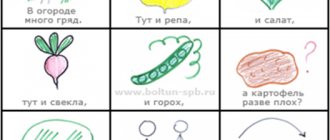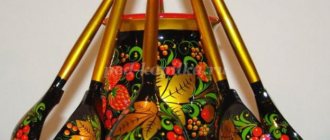Development of coherent speech in children through oral folk art
From the experience of working as a preschool teacher.
Development of coherent speech in children through oral folk art One of the most important tasks of teaching preschool children their native language is the development of coherent speech. The characteristic features of such speech are not only extensiveness and coherence, but also arbitrariness. These features of monologue utterance require special speech education and special training for the child. One of the forms of training is the development of coherent speech in children through oral folk art. Introducing children to oral folk art influences the comprehensive development of speech: sound culture, grammatical structure, vocabulary. Already from a young age, the foundations for the development of coherent speech are laid. This is necessary for further speech development. Children's folklore is a large part of oral folk art. Memorizing poems, nursery rhymes, lullabies, and fairy tales has a great influence on the development of coherent speech. The term “children’s folklore” usually refers to independent children’s creativity and works of traditional adult culture. Acquaintance with oral folk art with children begins with the first junior group. The work is carried out during scheduled moments, during classes, on walks, and during play. When putting the doll to bed, we sing:
Bye-bye, bye-bye, you little dog, don’t bark, don’t whine, don’t wake up my Katya.
In order for kids to remember the song faster and easier, it is necessary to show how loudly the dog (toy) barks and can wake up the Katya doll. The children unanimously ask the dog: “You are a dog, don’t bark, Beloloba don’t whine.” After such short plays, kids easily remember the songs and transfer them to everyday play. While washing and combing their hair, the kids get acquainted with the songs:
Clean water will wash Dima’s face, Katenka’s palms, and Alyosha’s fingers.
I scratch, scratch my hair, comb my scarf, grow the braid to the waist, don’t lose a hair. When going out for a walk, the teacher and the children read a nursery rhyme: We are going, going to see grandma and grandpa, on a horse, in a red hat, in an old little shoe, over potholes, over bumps. Folklore provides examples of Russian speech and imitation, which allows a child to more successfully master the Russian language. It is also important to introduce children to the most important details of the folk calendar. And when celebrating this or that holiday according to the calendar, one cannot do without songs. The songs are performed with movements, with repetitions, in the form of a dialogue: I sowed, sowed the flax, while I was sowing, I said, I nailed it with chabots, “You succeed, my little white flax.” Or: “And I’m walking through the meadow”, “Let’s go through the raspberries to the garden”, “Mother had six daughters” - game songs. And here are the carol songs. Before you sing them, you need to explain to the children what they mean (Kol - ada is a circle meal). Proverbs and sayings are called pearls of folk art. They influence not only the mind, but also the feelings of a person: the teachings contained in them are easily perceived. The proverb can be used in any situation. When getting ready for a walk, you can remind children who are slow to dress, “seven do not wait for one.” Noticing that one of the children is dressing sloppily: “If you hurry, you’ll make people laugh.” Younger preschoolers are especially attracted to poetic works that are distinguished by clear rhyme, rhythm, and musicality. With repeated reading, children learn the meaning of the poem, remember individual words and expressions, and thereby enrich their speech. Teach nursery rhymes about domestic and wild animals with your children. Such nursery rhymes, which help to learn about the habits of animals, are accessible to a child:
A horned goat is coming for the little guys Tail clap, clap Legs stomp, stomp!
Let's hit the horn! Damn to others! Gore, gore! In games during dressing, washing, after a nap, nursery rhymes are used in the work of the teacher. Many girls have nice long hair.
While combing your hair after sleep, we read a nursery rhyme: “Grow, braid, to the waist, Don’t lose a single hair, Grow your braid, to your toes, All the little hairs in a row.”
A fairy tale plays a great role in the speech development of a younger preschooler. It forms the linguistic culture of children, the ability to master the polysemy of folk speech. Retelling, repetition. Dramatization of fairy tales promotes the development of coherent speech in children. The language of fairy tales brings children and adults closer to each other. Children really enjoy listening to fairy tales and try to retell them. Fairy tales unite adults and children. Promotes mutual understanding. Riddles are of great importance; the teacher uses them in games, in class, and in work. On a walk, we observe natural phenomena, birds, and domestic animals:
A little boy in a gray army coat, Snoops around the yards, Collects crumbs, takes a walk in the field, steals grass” (sparrow) In the game, the riddle is also a distinctive assistant: if it falls, it will jump, it will hit, it will not (ball) will cry.
During the lesson, when describing the toy, children will not forget to say what the ball is for. When getting acquainted with modes of transport - a riddle about a bus:
A house goes down the street, It takes everyone to work. Not on chicken legs, but in rubber boots. Guessing riddles requires children to be able to reason and solve a logical problem creatively. Also, during walks, proverbs help children better understand various natural phenomena and events: “spring is red with flowers, and autumn with fruits.” From their own observations, children draw the conclusion “March is with water, April is with grass.” In everyday life, you can use proverbs about work: “the eyes are afraid, but the hands do the work,” “finish the job, walk boldly,” “the master’s work is afraid.” In older groups, you can organize competitions between groups of children: “Continue the proverb”, “Who can name the most proverbs (on the topic of friendship, work, etc.). But riddles are a useful exercise for a child’s mind. This is how Tikheyev suggests teaching children to solve riddles. Several toys or pictures are placed on the table and a riddle is selected for each. “The furry one walks, the bearded one walks, waving his faces, shaking his beard, tapping his hooves.” Or “there is a red comb on the head, a red beard under the nose, patterns on the tail, spurs on the legs.” It is necessary to draw children's attention to the apt figurative characteristics of the toy. Using riddles in classes (modeling, drawing, educational). It is very important to use riddles on a walk when children are watching trees, flowers or seasonal phenomena: “sisters are standing in the field - a yellow eye, white eyelashes”, “shouts “quack”, the enemy of worms.” All these genres are used when compiling entertainment dedicated to the holidays of the national calendar: “Candlemas”, “Vesnyanka”. Children should be taught using the best examples of their native language, and from an early age develop interest and love for folk epics, folk tales, proverbs, sayings, riddles, and the best examples of children's literature.
We recommend watching:
Scenario of winter entertainment for older preschoolers Summary of a lesson on speech development for the older group Author's folk song for preschoolers “Russian Dance” Musical pedagogical project in kindergarten. Senior group
Similar articles:
Scenario of a folklore holiday for older preschoolers
Thematic lesson in the senior group. Slavic mythology
Methods of conducting physical education classes in kindergarten
Folklore for children 2-4 years old in kindergarten
Lullabies in child development
Oral folk art as a means of speech development for children of primary preschool age
Oral folk art as a means of speech development
children of primary preschool age.
Katasonova N.I., teacher
MBDOU "CRR - kindergarten No. 22" Livny
In the 21st century, modern society widely uses technical means of communication, such as telephone communications, television and, of course, the Internet. And the high preoccupation of parents with everyday family problems greatly reduced the quality of communication between the child and the adult. This led to the emergence of various problems in the formation of communicative behavior of the younger generation. But the development of speech is inextricably linked with the formation of both the personality as a whole and all mental processes.
Thus, the problem of speech development of a preschool child becomes the most pressing. But how can this problem be solved effectively, especially when it comes to preschool age? And here the teacher comes to the aid of oral folk art. The brilliant creator of language and the greatest teacher - the people created such works of artistic expression that lead the child through all stages of his development.
Oral folk art is a special type of art that includes a large number of genres. Fairy tales, proverbs and sayings, ditties, chants and nursery rhymes, lullabies are the invaluable wealth of the Russian people. It is with the help of oral folk art that a child masters his native language, its melody, then the ability to understand its meaning, masters its beauty, laconicism, gaining ideas about the culture of his people. The entire centuries-old experience of the people and folk morality are concentrated in oral folk art. It contains a huge amount of information and establishes continuity between the past and the present. In no other works, except folk ones, will you find such an ideal arrangement of difficult-to-pronounce sounds, such an amazingly thoughtful combination of words that barely differ from each other in sound.
In works of oral folk art we see an abundance of words-attributes of objects, figurative comparisons, synonyms, antonyms. First, the child copies the movements and intonations with which the lullaby is sung, and then the words appear. At the same time, surprisingly quickly, many words of songs pass into the active vocabulary of children and are heard already during games and conversations with peers. Thus, lullabies contribute to the development of phonemic awareness. They enrich children’s vocabulary due to the fact that they contain a wide range of information about the world around them, primarily about those objects that are close to people’s experience and attract with their appearance, for example, “bunny”, “fox”, “top”. The grammatical variety of lullabies helps to master the grammatical structure of speech. I teach children to form words with the same root, as they create images that are well known to children, for example, the image of a cat. Moreover, this is not just a cat, but “kitten-cat”, “cat-white belly”, “cat”, “kitty”. In addition, positive emotions associated with one thing or another in a familiar way from the cradle make this development more successful and lasting. In lullabies, the role of improvisation is great: they are sung until the child falls asleep. At the same time, traditional, stable texts are of great importance. Nursery rhymes and pestushki are games with plot elements, games (“Ladushki, ladushki...”, “The horned goat is coming...”). Listings and dialogues appear in them. As in lullabies, rhythm is important in pestushki. A cheerful, intricate song with a clear chant of poetic lines puts a child in a joyful mood.
We also use various jokes for the speech development of younger preschoolers. These are songs or rhymes that captivate the child with their content. The plots of the jokes are very simple (single-motive or cumulative), reminiscent of “little fairy tales in verse” (V.P. Anikin). The jokes contain the first edifications: a stubborn goat is eaten by wolves; The little kitty didn’t leave the butter to treat the other... That is, they contain a lot of colorful and vivid verbal pictures, which allows you to enrich children’s vocabulary. Listening to them frequently helps preschoolers learn new forms of words for objects. The accumulation of such speech samples further contributes to the transition to linguistic generalizations. Reading jokes and nursery rhymes occurs with many repetitions, where individual words, phrases, sentences and even quatrains are repeatedly pronounced. All this contributes to memorizing words and then actively using them. Another value of nursery rhymes and jokes is that the word is connected to the child’s action. Their content is rich in verbs. Using them, the teacher demonstrates actions indicated by words, thereby connecting the word itself with the action. Calls and sentences play an important role in speech development. These are genetically the most ancient forms of children's verbal games. By origin they are associated with the calendar rituals of adults. Oral sentences also passed from adults into children's lives. These are short, usually poetic appeals to animals and birds, ladybug, bees; to the mouse with a request to replace the old, fallen tooth with a new, strong one; to the hawk so that it doesn’t circle over the house and look out for chickens. Calls are songs addressed to nature (sun, rain, rainbow) and expressing a call or request. The content of the chants is close to the concerns and aspirations of farmers: the need for rain or, on the contrary, sunshine.
The chants are shouted out in chorus, in a chant. In contrast, sentences are pronounced individually and quietly. Their content includes a request-conspiracy addressed to a snail, ladybug, mouse... This contributes to the development of monologue and dialogic speech. And children develop their organs of articulation in tongue twisters, which require the repetition of difficult to pronounce words. In the process of organizing various types of activities with children, I use proverbs and sayings in my speech, since they are figurative, poetic, endowed with comparisons, vivid epithets, they contain a lot of personifications and small definitions. Children's understanding of proverbs and sayings depends on the degree of their allegory. They are not always clear to children and require clarification. It is necessary to use proverbs in the context of activity under appropriate conditions, which will make their meaning clear. Proverbs and sayings are pronounced expressively, with different intonations (with surprise, condemnation, regret, joy, satisfaction, affirmation, etc.), and are also accompanied by facial expressions and gestures. Expressive intonation and gestures help to understand the essence of the proverb and encourage children to take the desired action. This also helps children overcome difficulties in constructing free-form phrases when expressing their thoughts.
Every child, of course, enjoys a great love for fairy tales. From a very early age, a child gets acquainted with a fairy tale told by his mother or grandmother, and experiences certain feelings and experiences. Folk tales contain invaluable content. Thus, in relation to the saturation of artistic speech with linguistic means of expressiveness - epithets, comparisons, synonyms, antonyms, etc. (for example, clear falcon, beautiful maiden, stand in front of me like a leaf in front of the grass). A fairy tale allows children to clarify and expand their vocabulary, teaches them to use particles and prepositions in speech, develops practical skills in word formation and inflection, and teaches them to use simple sentences in speech. All this is the basis for the successful development of a child’s coherent speech with the coordination of words in a sentence in gender, number, case, and tense.
Imagery is an important feature of fairy tales, which facilitates their perception by children who are not yet capable of abstract thinking. The fun nature of fairy tales increases children's interest in them. Didacticism is one of the most important features of fairy tales of all peoples of the world. These features of fairy tales make it possible to use them in solving pedagogical problems. A child’s journey into the world of a fairy tale develops children’s imagination, fantasy, and encourages them to write. Children brought up on the best literary examples in the spirit of humanity show themselves to be fair in their stories and fairy tales, protecting the offended and weak and punishing the evil. Children should derive both aesthetic and especially moral (ethical) ideas from works of art, and not from the moralizing arguments of teachers about the works they read.
Ushinsky gave an exhaustive assessment of the tale, saying: “These are the first and brilliant attempts of Russian folk pedagogy, and I don’t think that anyone would be able to compete in this case with the pedagogical genius of the people. A folk tale is easy for children to read simply because in all folk tales the same words and phrases are constantly repeated, and from these incessant repetitions, which perfectly satisfy the pedagogical meaning of the story, something whole, harmonious, easily perceptible, full of movement and life is formed and interest."
Thus, the use of oral folk art in organizing various types of children's activities allows me, as a teacher, to solve the problems of speech development of children of primary preschool age, making the process itself exciting and natural for kids. But not a single task can be effectively solved without the participation of parents. Therefore, I try to convey to them the importance of using folk art in family communication, develop and maintain interest in oral folk art. After all, only joint efforts to create favorable conditions for children to master the language of folk art that is accessible to them can have a huge educational and developmental impact on a preschool child.
Bibliography
1. Big book of Russian folk tales. - M.: Makhaon, 2010. - 176 p.
2. Budarina T.A., Korepanova O.N., Kuprina L.S., Markeeva O.A. Introducing children to Russian folk art. - M.: Detstvo-Press, 2010. - 400 p.
3. Gavrilova I.G. The origins of Russian folk culture in kindergarten. - St. Petersburg: Detstvo-Press, 2010. - 160 p.
4. V.V. Gerbova Speech development in kindergarten. Junior group. For classes with children 3-4 years old. Federal State Educational Standard
5. Dmitrieva V. 1000 poems, counting rhymes, tongue twisters, proverbs for reading at home and in kindergarten. - M.: Astrel, Poligrafizdat, Sova, 2012. - 496 p.
6. Kapitsa F.S., Kolyadich T.M. Russian children's folklore: Textbook. allowance. - M.: Flinta, 2002. - 320 p.





